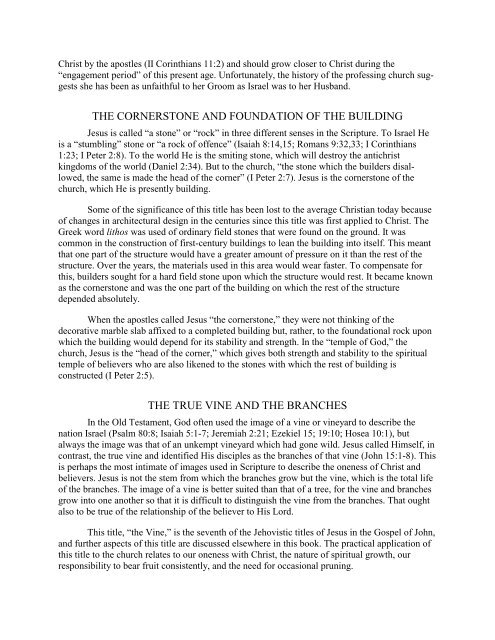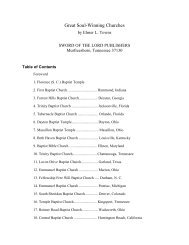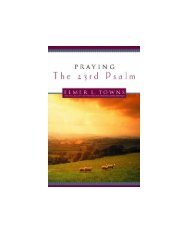The Names of Jesus - Elmer Towns
The Names of Jesus - Elmer Towns
The Names of Jesus - Elmer Towns
- TAGS
- elmer
- towns
- elmertowns.com
You also want an ePaper? Increase the reach of your titles
YUMPU automatically turns print PDFs into web optimized ePapers that Google loves.
Christ by the apostles (II Corinthians 11:2) and should grow closer to Christ during the<br />
“engagement period” <strong>of</strong> this present age. Unfortunately, the history <strong>of</strong> the pr<strong>of</strong>essing church suggests<br />
she has been as unfaithful to her Groom as Israel was to her Husband.<br />
THE CORNERSTONE AND FOUNDATION OF THE BUILDING<br />
<strong>Jesus</strong> is called “a stone” or “rock” in three different senses in the Scripture. To Israel He<br />
is a “stumbling” stone or “a rock <strong>of</strong> <strong>of</strong>fence” (Isaiah 8:14,15; Romans 9:32,33; I Corinthians<br />
1:23; I Peter 2:8). To the world He is the smiting stone, which will destroy the antichrist<br />
kingdoms <strong>of</strong> the world (Daniel 2:34). But to the church, “the stone which the builders disallowed,<br />
the same is made the head <strong>of</strong> the corner” (I Peter 2:7). <strong>Jesus</strong> is the cornerstone <strong>of</strong> the<br />
church, which He is presently building.<br />
Some <strong>of</strong> the significance <strong>of</strong> this title has been lost to the average Christian today because<br />
<strong>of</strong> changes in architectural design in the centuries since this title was first applied to Christ. <strong>The</strong><br />
Greek word lithos was used <strong>of</strong> ordinary field stones that were found on the ground. It was<br />
common in the construction <strong>of</strong> first-century buildings to lean the building into itself. This meant<br />
that one part <strong>of</strong> the structure would have a greater amount <strong>of</strong> pressure on it than the rest <strong>of</strong> the<br />
structure. Over the years, the materials used in this area would wear faster. To compensate for<br />
this, builders sought for a hard field stone upon which the structure would rest. It became known<br />
as the cornerstone and was the one part <strong>of</strong> the building on which the rest <strong>of</strong> the structure<br />
depended absolutely.<br />
When the apostles called <strong>Jesus</strong> “the cornerstone,” they were not thinking <strong>of</strong> the<br />
decorative marble slab affixed to a completed building but, rather, to the foundational rock upon<br />
which the building would depend for its stability and strength. In the “temple <strong>of</strong> God,” the<br />
church, <strong>Jesus</strong> is the “head <strong>of</strong> the corner,” which gives both strength and stability to the spiritual<br />
temple <strong>of</strong> believers who are also likened to the stones with which the rest <strong>of</strong> building is<br />
constructed (I Peter 2:5).<br />
THE TRUE VINE AND THE BRANCHES<br />
In the Old Testament, God <strong>of</strong>ten used the image <strong>of</strong> a vine or vineyard to describe the<br />
nation Israel (Psalm 80:8; Isaiah 5:1-7; Jeremiah 2:21; Ezekiel 15; 19:10; Hosea 10:1), but<br />
always the image was that <strong>of</strong> an unkempt vineyard which had gone wild. <strong>Jesus</strong> called Himself, in<br />
contrast, the true vine and identified His disciples as the branches <strong>of</strong> that vine (John 15:1-8). This<br />
is perhaps the most intimate <strong>of</strong> images used in Scripture to describe the oneness <strong>of</strong> Christ and<br />
believers. <strong>Jesus</strong> is not the stem from which the branches grow but the vine, which is the total life<br />
<strong>of</strong> the branches. <strong>The</strong> image <strong>of</strong> a vine is better suited than that <strong>of</strong> a tree, for the vine and branches<br />
grow into one another so that it is difficult to distinguish the vine from the branches. That ought<br />
also to be true <strong>of</strong> the relationship <strong>of</strong> the believer to His Lord.<br />
This title, “the Vine,” is the seventh <strong>of</strong> the Jehovistic titles <strong>of</strong> <strong>Jesus</strong> in the Gospel <strong>of</strong> John,<br />
and further aspects <strong>of</strong> this title are discussed elsewhere in this book. <strong>The</strong> practical application <strong>of</strong><br />
this title to the church relates to our oneness with Christ, the nature <strong>of</strong> spiritual growth, our<br />
responsibility to bear fruit consistently, and the need for occasional pruning.
















